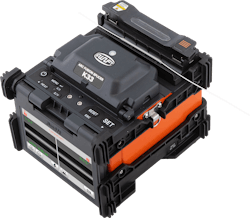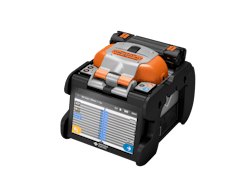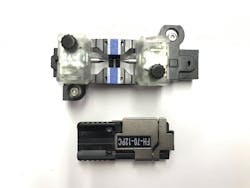By Patrick McLaughlin
Fusion splicing once was a specialized task mastered by very few, who were highly skilled at using the complex and expensive equipment required to fuse optical fibers together. Over the past several years, the evolution of fusion-splicing equipment has opened the process to more professionals and more network owners. One aspect of that evolution is the declining cost of splicers.
“Electronic and electro-mechanical component prices have dropped substantially in the past decade,” explains Lucas Mays, applications engineer with AFL. “The continued rise of the smart phone, smart homes, cars, etc. has proliferated electronics in much more of our society than ever before. This has greatly increased the volumes of these parts to the global market, therefore decreasing the cost of said components. Single fiber splicers have experienced the largest price concessions. Core-alignment splicers specifically have seen the largest percentage drop, even though they are not the lowest-cost splicer. The competition for single fiber splicers is greater—there are far fewer mass fusion splicing OEMs in the world compared to single, hence greater reductions.
“Mass fusion seems to be more trivial than core alignment to some, since the V-grooves do not move, but repeatability of a high-quality mass-fusion splice where each of the 12 fibers is heated evenly over thousands of splices, is no trivial task. Not to mention the accuracy needed when manufacturing splicer V-grooves so each one is perfectly aligned with its adjacent and opposite V-groove. The cost and technology barrier for mass fusion splicing is higher, hence less competition.”
Brad Everette, general manager of America Ilsintech adds, “Yes, splicer prices have come down over the years, but the expansion of splicing technology drives a lot of economics also. North American price points among industry leaders is US$4,000 to US$5,000 for a 4-motor clad splicer, US$8,000 to US$10,000 for a 6-motor core splicer, and about US$10,000 to US$12,000 for a mass or ribbon splicer. There are several contributing factors to this.
“The degree of cost-effectiveness will be based on your splicing history. While splicer prices decline slightly from year to year, you will recognize a more dramatic decline if you were pricing one 15 years ago. Most will remember the days of splicing being a very skilled and manual process, and will also remember the splicer being the size of a suitcase and costing $25,000. The initial dramatic decrease was realized in the alignment technology that greatly reduced the size and increased the portability of fusion splicers. Top-tier manufacturers continue to identify ways to reduce production costs in a way that does not compromise product quality.
“Although splicer technology has progressed, the related components—strippers, cleavers, cleaners—have remained relatively consistent and become more commoditized, leading to lower kitted costs,” Everette continued. “Volume commitments from major service providers and contractors have allowed improved economies of scale at the manufacturing level. The user with 10 or fewer machines benefits from the company that buys hundreds or thousands of units annually.”
Joshua Seawell, director of product management with Sumitomo Electric Lightwave, observes, “In the industry we’ve seen the rapid deployment of optical network with strict timelines, and especially since 2020, stricter budgets. This all plays into fusion splicer pricing trends. When looking at the cost of a fusion splicer, it is important to consider the tradeoff between a lower-priced unit to a higher-priced one. Typically, when considering a single-fiber splicer, a clad-alignment unit will be significantly lower priced than a core-alignment unit. What also comes into play is what the splicer is used for. A clad-alignment splicer is typically used where higher loss is acceptable or legacy fiber is not spliced. A core-alignment unit is considered when it is essential to identify the fiber core and splice with the lowest possible loss to not compromise signal integrity. At Sumitomo Electric we offer a wide range of high-performing fusion splicer models for every budget.
“When look at mass or ribbon splicing, as the industry continues to demand splicing efficiency in relation to speed and splicing results for 200 µm fibers and various ribbon structures—conventional flat and pliable—the cost aspect is analyzed based on product quality. Our engineering excellence is driven by the highest quality materials. Although we know we do not carry the lowest-priced splicers in the industry, our quality is reflected in our machines—everything from the V-grooves to the microscopes to the subcomponents of our motors to create a workhorse, which our technicians can continue to use for years t come.”
America Ilsintech’s Everette echoes those sentiments about quality: “To debunk a thought that would mistaken seem obvious, one would incorrectly expect ‘economic alternatives’ to be impacting price points in the splicer market. Market feedback and reporting indicates that customers consider their splicing equipment to be among their mission-critical hardware. They demand quality and performance consistent with top-tier manufacturers. Installers are seldom willing to compromise the quality, service and support they receive at this level. Market-share reports support this commitment showing little market growth by lower-tier participants, or participants who consider splicers an add-on to their product lines.”
Everette further explains the far-reaching effects of cost savings associated with fusion splicing. “Expansion of products using fusion splicing as a connectivity method is expanding the utilization of splicing beyond the traditional outside plant world,” he says. “Contractors can now utilize their splicing equipment to terminate fusion splice-on connectors and rack-mounted cassette modules in their enterprise and data center segments, which offers a broader return-on-investment calculation for the splicer purchase. Depending on performance expectation and cable construction, this could involve active clad, core, and/or ribbon splicers.
“Improved network performance is increasing the value of fusion splicing,” Everette adds. “There was an initial sure in singlemode applications—primarily in APC but also in UPC—which has now found its way into multimode applications as well. The performance of fusion splicing establishes itself as an alternative to preterminated solutions, further expanding the use of fusion splicers and the ROI calculation.
“Also, the durability of fusion splicing versus mechanical contributes to the long-term economics. Realities like temperature cycling and aging of index matching gels cause mid-term failures to mechanical splices and connectors. Many specifiers are demanding fusion splicing as a long-term economic protection against service truck rolls.
“In short, while the pricing has come down on the machines themselves, it is the expanded use of fusion splicing and the performance benefits that are increasing the cost effectiveness of the equipment. Fiber installers understand this trend and are finding their fusion splicer to be one of their best tool investments.”
One-stop shop
An installer or technician who conducts fusion splicing must be trained and familiar with several processes, including proper cleaving, cleaning, and other practices. It is advantageous for these professionals to have a one-stop shop, to the extent possible, for the products and the processes involved from the beginning to the end of the fusion-splicing process. Fusion-splicer providers are accommodating.
Everette points out, “Swift-branded splicers from America Ilsintech are sold in kit form to ensure the customer’s expectations are met upon arrival. Kits are configured during the consultation and quotation process to include the stripping, cleaning, cleaving, splicing, and sleeving tools required by the customer to suit their splicing and connectivity application intentions. Our kitted options are available for active clad, core, and ribbon splicing and comes in two forms. All-in-one splicers have all functions built into the unit. This assures that all tools are where they need to be at the time of use. The all-in-one design offers several benefits from site organization to an often-recognized safety factor. From a design standpoint, each step and function has been located to maximize efficiency and encourage repetition leading to workflow consistency.
“America Ilsintech also offers standalone kit options that meet the traditional kit configurations that include manual strippers, pump cleaner fluid bottle and manual cleaver to accompany the splicer selected.”
Seawell notes, “Our fusion splicer kits come equipped with all the components required to splice from the moment the case is opened. In essence, the kit having essentially required materials is a one-stop shop. While other manufacturers have combined platforms for fusion splicing and cleaving, for example, Sumitomo Electric considers the machines as separate products. Our methodology is, if the machine is independent of the accessories, the splicer kit components are able to be independently serviced, which further reduces downtime while a replacement unit can be provided for the product under repair.
“When a new technician is utilizing a Sumitomo fusion splicer for the first time, we want to offer as many learning resources as possible. We facilitate training by offering hands-on demonstrations, classroom seminars, 24/7/365 technical support on all our product lines, including user tips and guidelines, printed and digital manuals that can be downloaded from our website, and preloaded videos on our fusion splicers to aid technicians in all the essential steps of the fusion splicing process.
“What makes AFL unique is the end-to-end solutions we provide,” says Mays. “Not only do we have splicing kits, but we sell our own line of cleaning products for both fiber and connector cleaning. To go along with splicing and cleaning, we offer a full line of test and inspection products so the full breadth of equipment needed for any cable repair or installation can be acquired at our one-stop shop. AFL manufactures everything from fiber-optic cable to connectivity, and we are available 24/7 for technical support.”
Splicing high-fiber-count cables
The deployment of extreme high-fiber-count cables is shining a spotlight on fusion splicing. These cables incorporate many ribbons and in total include thousands of fibers. To minimize cable diameter, many manufacturers are using 200-micron fibers rather than 250-micron fibers in these cables. In some cases, these 200-micron fibers are splices to 250-micron fibers, creating a potential challenge. Splicer manufacturers are taking several measures to help installers meet and overcome this and similar challenges.
“Ribbon splicing, by nature, can be finicky and detailed work due more to the fiber preparation and handling than the splicer itself,” explains America Ilsintech’s Everette. “With that I consider it a specialized art within an expertise. When selecting a ribbon splicer, special attention should be paid to the training and support made available from the manufacturer. When splicing ribbon fiber, and especially high-fiber-count ribbonized cables, installers should align themselves with a manufacturer based initially on product performance and configuration, but just as importantly on the application expertise, local product support and related products available.
“In splicing 200-micron ribbon, top-tier splicer manufacturers have product options that use V-grooves at the proper pitch to splice the fibers in the same manner as 250-micron. Some manufacturers require a separate splicer purchase for this type of splicing, while others have an option for field modification to an existing splicer.
“Top-tier manufacturers offer a ‘fiber holder’ option that spaces the 200-micron to a 250-micron pitch, thereby aligning the fibers for termination in legacy ribbon splicers. In this case, the standard termination practices apply. However, this opens the door to another application environment, which is splice-on MPO connectors. If termination of MPO connectors is part of a company’s needs, we highly recommend that this be considered as part of the splicer selection process. Most top-tier splicer manufacturers offer splice-on MPO connectors as part of their product offering but understanding the intricacies of the 200-micron-to-250-micron termination should be part of their application expertise. Consideration of this expertise along with local product support and access to related products should all be part of the purchase criteria.
“This points to another area sharing the spotlight in splicing, which is fusion splice-on connectivity [FSOC]. FSOC is the fastest-growing segment of fiber connectivity in today’s market. This includes LC, SC, ST, FC and MPO connector types in singlemode and OM 1-5. Fusion splicers related to the termination of these connectors represent the market growth in this category. This connector technology is the primary component in the use of fusion splicers outside the traditional splicing applications.”
Sumitomo Electric Lightwave’s Seawell says, “Our Type-Q102-M12 Ribbon Fiber Splicer is capable of splicing 200-micron to 250-micron fibers utilizing our patented FHM-PCH-12 Pitch Conversion holders. These holders facilitate the transition from 200-micron to 250-micron architectures. For a network demanding 200-micron fusion splicing, Sumitomo has a broad offering of custom-tailored solutions including a dedicated 200-micron fusion splicer with a rapid 11-second splice time, 35-second heater time, and 0.05-dB average splice loss per 12-count ribbon. Key features of the Type-Q102-M12-200 include the patented ACAS [Auto Clamping Adjustment System], which dramatically minimizes fiber offset and delivers a repeatably low-loss splice. It includes our signature dual independent ovens, reducing heating time by 17%.”
Mays of AFL states, “If possible, the best solution is to avoid the situation altogether. AFL offers 200-micron fibers at a 250-micron pitch, so they are spaced the same as traditional 250-micron ribbon, yet retain the lighter weight, smaller outside diameter, and other benefits of 200-micron fiber. This allows for backwards splicing compatibility with no new equipment or processes. If and when you do find yourself in need of splicing two different 200-micron constructions or 200-micron to 250-micron with differing pitch, AFL has various solutions depending on the situation at hand.“We offer a selection guide to help show a user what’s needed for the different splicing combinations of 200-to-200 micron, 200-to-250 micron, etc. Also, depending on the holder/ribbon, there are different techniques for some that can be found in the selection guide. 200-micron has certain complicated splicing, requiring even veteran splicers to learn new tricks. Not every OEM has solutions for every situation, so be sure you can acquire what’s needed before bidding on that splicing job.
“The most common 200-to-250-micron splicing we see today is in stranded fiber cable, where the 200- to 250-micron fibers are not in a ribbon and must be ribbonized to be spliced. AFL has a unique glue-less ribbonizing tool that collects the fibers in the proper color-code array and loads them directly into the fiber holder. This process can be used with 200- or 250-micron using the same tool, just a different fiber holder. The holder used for stranded 200-micron fibers, converts the pitch, or spacing, from 200- to 250-micron in the holder, to be easily spliced in a traditional splicer to 250-micron fibers.”
Patrick McLaughlin is our chief editor.


